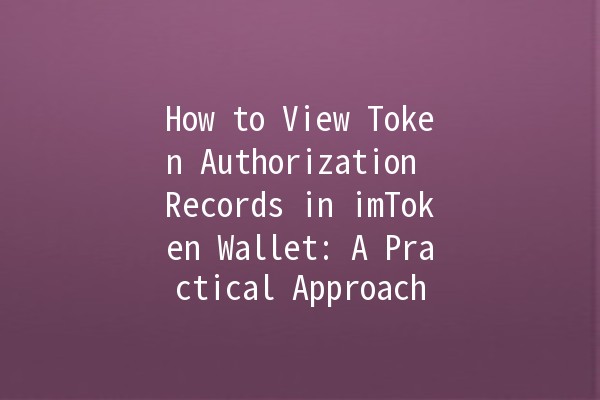In the digital currency ecosystem, managing tokens securely is crucial for users. One essential aspect of this management is understanding token authorization records within your wallet. This article provides insights into how to view token authorization records in the imToken wallet, offering practical tips to enhance your productivity in managing tokens effectively.
Token authorization in the imToken wallet refers to the permissions granted for various tokens, allowing decentralized applications (dApps) to access your tokens. Understanding how to manage and monitor these authorizations can protect your assets from unauthorized access.

Before viewing your authorization records, you need to access your imToken wallet. Follow these steps:
This initial step is crucial as it serves as the gateway to managing your tokens effectively.
Once you are logged into your wallet, follow the navigation steps to reach token management:
Within the token management section, you can see detailed information, including the token’s current value and the total units held.
To view the specific authorization records for a token, continue with these steps:
By regularly checking these records, you can identify if any unauthorized access has occurred, ensuring that your tokens remain secure.
Managing your tokens efficiently can save time and enhance overall productivity. Here are five practical tips for using the imToken wallet:
Explanation: Establish a routine for checking your token authorization records.
Example: Set a weekly reminder to review which dApps have access to your tokens. This practice helps identify and revoke access from any dApps you no longer use, thereby minimizing risk.
Explanation: Ensure your wallet is secured with a complex password.
Example: Use a combination of letters, numbers, and special characters to create a strong password. This step adds an additional layer of protection against unauthorized access.
Explanation: Regularly update your imToken wallet app.
Example: By keeping the app updated, you gain access to the latest security features and fixes, protecting your assets against vulnerabilities.
Explanation: Use 2FA for additional security when accessing your wallet.
Example: Link your wallet to a 2FA app to add a layer of security. Whenever you log in, you’ll need to provide a verification code, boosting your wallet’s protection.
Explanation: Familiarize yourself with the decentralized applications (dApps) you interact with.
Example: Research the dApps you use to understand their legitimacy and security measures. Use resources like community feedback or reviews to make informed decisions.
Revoking access involves navigating to the authorization section of the selected token and selecting the dApp you wish to remove. Follow the prompts to confirm the revocation.
If you suspect unauthorized access, promptly revoke the dApp’s access and change your wallet password immediately. Monitor your wallet for any unusual activity thereafter.
It is advisable to check your token authorizations regularly, ideally at least once a week, to maintain a secure wallet.
Revoking access does not result in the loss of tokens. The dApp will no longer have access, but your tokens remain within your wallet.
Leaving dApps authorized increases the potential risk of unauthorized access to your tokens. If a dApp is compromised, it could lead to significant losses.
While imToken does not directly show transaction history for each dApp, users can check their primary transaction history in the wallet to see movements related to authorized dApps.
, understanding how to view token authorization records in the imToken wallet is vital for securing your digital assets. By proactively managing and monitoring these records, you can enhance your experience in the cryptocurrency space and ensure your tokens remain safe. Regular audits, strong passwords, ongoing education, and keeping software updated are all vital practices that contribute to a secure and productive use of your wallet.